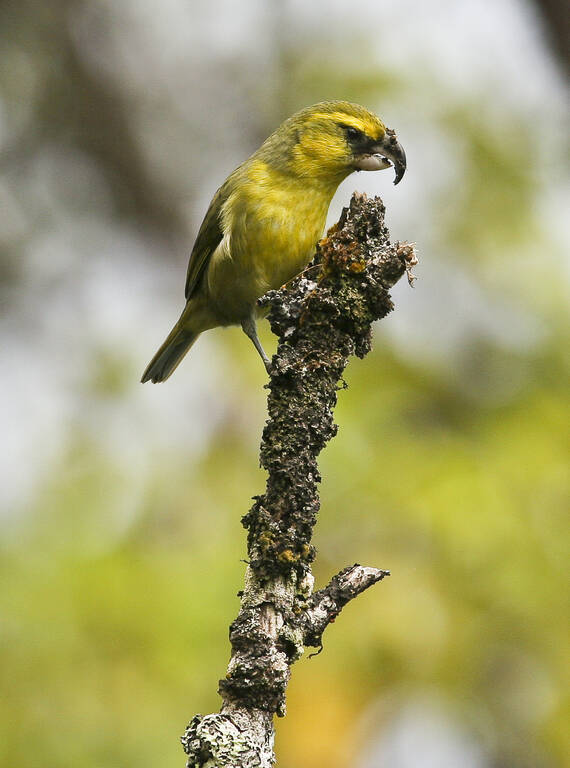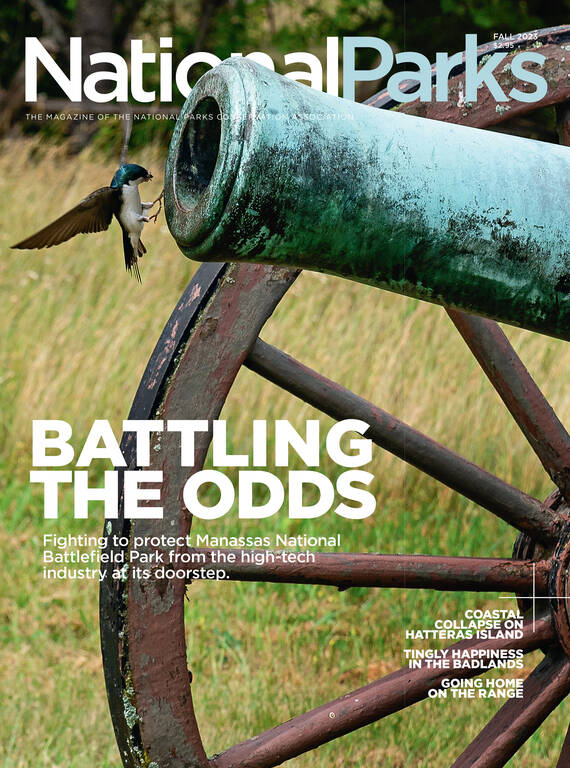Fall 2023
Buzz Kill
A high-tech mission to save critically endangered forest birds takes flight at Haleakalā National Park.
Honeycreepers were once a familiar sight throughout the Hawaiian Islands. Decked out in brilliant red, yellow, orange or green feathers, dozens of species of these melodic birds flitted through the forest from sea level to tree line, dipping their beaks into flowers for nectar or cracking open berries in search of the larvae within. “When the first Hawaiians came here, they would have been greeted with a chorus, just an abundance of these birds,” said Lukanicole Zavas, an outreach manager at the American Bird Conservancy. And by pollinating native plants and keeping insect populations in check, “Hawaiian honeycreepers helped facilitate the beautiful biodiversity once found on all the main islands,” she said.
But unfortunately, hundreds of years of human activity have taken a grave toll on Hawaii’s honeycreepers. “It’s stark to think that I’ve lived in Hawaii almost my whole life, and I didn’t see a single Hawaiian honeycreeper until I was in college,” Zavas said. “And even then I had to climb way to the tiptops of mountains to see them.”
It’s a familiar story: Roads, homes and ranchland have replaced much of the birds’ forest habitat. Also, introduced predators such as rats and mongooses go after their nests. But by far the most devastating introduction was avian malaria. Since the mosquito-borne disease made its appearance in Hawaii in the early 20th century, it has churned through honeycreepers on every island, causing their red blood cells to rupture and killing nearly all of the birds that contract it. Today, most of the honeycreepers that remain can be found only in remote, high-elevation forests that have historically been too cold for the southern house mosquito, the invasive insect that spreads the disease. (Hawaii had no mosquitoes at all until 1826, when a whaling ship carrying some in its hold docked on Maui. Within decades, mosquitoes and the diseases they carry had spread to every island.)
One such honeycreeper redoubt can be found in Maui’s Kīpahulu Valley within Haleakalā National Park. For decades, as honeycreeper species such as kiwikiu and ʻākohekohe have disappeared from the rest of the island, biologists have been keeping tabs on what’s seemed to be a pretty steady population of these birds within about 11 square miles of forest, spanning parts of Kīpahulu and surrounding protected lands above 5,000 feet of elevation.

The National Park with the Most Endangered Species
NPCA recently worked with Defenders of Wildlife to determine how many endangered species have critical habitats that include national park sites. One park has significantly more of these rare plants…
See more ›“Ten years ago, everywhere we’d go search for kiwikiu in that forest, they were there,” said Chris Warren, the forest bird program coordinator at Haleakalā National Park. Warren knew the birds’ overall situation was dire: Of the 20 or so honeycreeper species once found on Maui, only six remain on the island and half are threatened or endangered. But he could take a little comfort in the fact that the birds still had a stronghold, high on the mountain, where malaria and mosquitoes couldn’t touch them.
Until, alas, they could. By 2019, surveys in the Kīpahulu Valley were turning up malaria-positive mosquitoes above 5,000 feet — and malaria-positive birds at all elevations. That same year, Warren was part of an effort to reintroduce the critically endangered kiwikiu to a patch of restored forest on the southern shoulder of Haleakalā, Maui’s 10,000-foot volcano, in an area that was thought to be above the mosquito line. “We spent seven or eight years planting, fencing, removing invasive species, trying to improve that habitat as best we could before the translocation,” Warren said. Of the 14 birds released in October 2019, 10 were dead of malaria by November, and the remaining four vanished.
The culprit? Climate change. “Now we’re understanding that warmer temperatures and changes in precipitation patterns have allowed mosquitoes and malaria to encroach on the last places these birds have,” Warren said. “They’re out of mountain. They don’t have anywhere left to run.” In just the past decade, the ʻākohekohe population has gone below 2,000, and kiwikiu have sunk from some 500 to possibly 150. “All of the remaining kiwikiu in the world collectively weigh about as much as one gallon of milk,” Warren said.

In the past decade, the total population of the kiwikiu (pictured) has sunk to possibly 150 individuals. “All of the remaining kiwikiu in the world collectively weigh about as much as one gallon of milk,” said Chris Warren, the forest bird program coordinator at Haleakalā National Park.
©ERIC VANDERWERFThe birds’ decline has continued despite decades of efforts to save them. Conservationists have tried excluding humans from vast areas of the island, fencing off honeycreeper habitat to keep out feral goats and pigs, trapping and poisoning predators, replanting forests, translocation, and breeding birds in captivity. But none of these strategies has halted the spread of malaria. After the failed kiwikiu reintroduction in 2019, scientists realized they needed “a change of mindset,” Warren said. “We realized we have to do something about the mosquitoes.”
So Warren and his colleagues at Haleakalā looked at a vast array of possible solutions, from the conventional (hosing the forest with pesticides) to the Sisyphean (draining all the puddles where mosquitoes breed) to the futuristic (using gene editing technology to engineer malaria-proof mosquitoes or birds). Those ideas were quickly dismissed. In the end, following extensive consultation with experts and interested members of the public, they settled on a strategy known as the incompatible insect technique, or IIT.
Counterintuitively, IIT works by releasing many more mosquitoes into the forest. The new arrivals are all males, and they’re bred in a lab to carry a particular strain of a bacteria called Wolbachia in their reproductive organs. The bacteria, several different strains of which are already present in a range of insect species on Maui, produce proteins that interrupt the development of mosquito embryos formed when the introduced males breed with wild females, which don’t carry a similar strain of Wolbachia in their own sex cells. If you release enough “incompatible” male mosquitoes in an area — somewhere between 10 and 20 lab-bred males to every wild female — the females will have a slim chance of encountering males with which they can produce viable offspring. IIT, which has been deployed around the world against mosquitoes that spread human disease since the late 1960s, can cut a local mosquito population by more than 90% within weeks or months.
“This technique is very powerful,” said Zhiyong Xi, an IIT expert at Michigan State University who’s one of the advisors to the Park Service on this project. “It’s not like a traditional chemical, because insects eventually develop resistance to those. So when you continue using chemicals, eventually you select a highly resistant mosquito population, and then you’re not able to further push down the population.” Pesticides, of course, can also kill beneficial insects, while IIT precisely targets the troublesome mosquito. And male mosquitoes don’t bite, so there’s no risk that the lab-raised cohorts will worsen the spread of avian or human disease.

Bird’s Best Friend
Turning to the very goodest dog in the race to save Hawaii’s endangered seabirds.
See more ›Still, Xi is accustomed to a certain amount of wariness about IIT. “People worry: how can you spread a bacteria in our community? But Wolbachia is not a normal bacteria like in people’s minds. It cannot cause infection,” he said. That’s because, unlike bacteria that cause infectious disease, Wolbachia can only live within their hosts’ sex cells and is only transmitted from a mother to its offspring. When a Wolbachia-carrying bug dies, its Wolbachia die with it and can’t spread to other organisms in its environment. And Wolbachia can only infect invertebrates, so mammals and other species are in the clear.
Warren added that since regulations were introduced in the 1970s, no intentional, regulated biocontrol program has “attacked native species or had unintended negative consequences. The truly problematic species are those introduced without regulation or unintentionally introduced.” Regardless, the Park Service’s plan for Maui’s mosquitos doesn’t entail introducing any species that aren’t already widely distributed in Hawaii. Even the specific bacterial strain used to breed the incompatible male mosquitoes at Haleakalā is Maui-grown: Scientists in a lab in California isolated a strain of Wolbachia from another species of mosquito on the island, the Asian tiger mosquito. They then bred a population of Maui’s southern house mosquitoes, dosed them with antibiotics to kill off their existing Wolbachia colony, and injected the incompatible strain from the Asian tiger mosquito into the southern house mosquitoes’ sex cells. This step can be a bit fiddly, Xi acknowledged — the needles the lab uses must be very small — but “once one mosquito is generated carrying this bacteria, then all you need to do is breed this mosquito” to generate a line of southern house mosquito that’s incompatible with Maui’s invasive bugs, Xi said.

National Parks
You can read this and other stories about history, nature, culture, art, conservation, travel, science and more in National Parks magazine. Your tax-deductible membership donation of $25 or more entitles…
See more ›But breeding zillions of mosquitoes in a lab in California is just the start. Next, the incompatible males must be carefully separated from the females and kept alive long enough to be shipped across the ocean. Then they will be packed into the bellies of drones and released, tens of thousands at a time, across east Maui’s dense, trackless forest at regular intervals. The Park Service released its first batch of mosquitoes into a small study area this spring. The agency plans to deploy the drones this fall and gradually expand its coverage as it works out the kinks in its process and gathers data on the treatment’s effectiveness. (A statewide working group is meanwhile considering other areas where IIT could save species on the brink of extinction, such as on Kauai, where the population of an endemic honeycreeper called the ʻakikiki fell from 500 in 2018 to 10 in 2023.)
At least for now, the Park Service only plans to use IIT in the areas on Maui where honeycreepers are already taking refuge. So even if a single application of incompatible males eradicates the local mosquito population, Warren said that bugs from elsewhere on the mountain will eventually move back in, meaning the Park Service will need to keep this routine up “until some other tool comes along that is somehow better or more permanent.” If nothing is done, these species could go extinct within the next 10 years, Warren said, and for the time being IIT is the park’s best option: “Right now, we can do this at a scale that will save these birds.”
As the magazine went to press, fires were devastating Maui, and the human toll was still unknown. At that time, it appeared the fires had not affected the Kīpahulu District of Haleakalā National Park though they did cause the park’s closure.
About the author
-
 Julia Busiek Author
Julia Busiek AuthorJulia Busiek is a writer living in Oakland. She's worked in national parks in Washington, Hawaii, Colorado and California.



